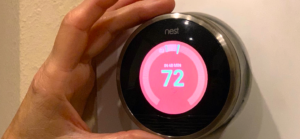We understand how frustrating it can be when your thermostat says heat, but there’s no heat coming from your heater. This is a common issue that many homeowners face, especially during the cooler months. In this article, we’ll walk you through some common reasons why this happens and what you can do about it.
Common Reasons for Thermostat Saying Heat but No Heat
Dirty Filter
One of the most common reasons for a heater not working properly is a dirty filter. A clogged filter restricts airflow, causing your heater to work harder and eventually stop heating.
To check and replace the filter:
- Turn off your heater.
- Locate the filter compartment.
- Remove the filter and inspect it. If it’s dirty, replace it with a new one.
- Ensure you’re replacing the filter regularly, at least every three months, to maintain optimal airflow and efficiency.
Regular filter maintenance is crucial for keeping your heater running smoothly and efficiently.
Gas Supply Issues
For those using gas heaters, it’s essential to ensure that the gas supply valve is open. Without gas, your heater cannot produce heat.
To check the gas supply:
- Locate the gas valve near your heater.
- Make sure it is in the open position.
- If the valve is off, carefully turn it on.
Be cautious about gas leaks. If you smell gas or suspect a leak, turn off the gas immediately and call a professional for assistance. It’s always better to be safe and rely on professional help when dealing with gas supply issues.
Incorrect Thermostat Settings
Sometimes, the problem lies in the thermostat settings. Ensure your thermostat is set to a temperature above the current room temperature.
Here’s how to check and adjust the thermostat:
- Set the thermostat to the highest heat setting temporarily.
- Make sure the system switch is set to “Heat.”
- Check the fan setting and ensure it’s on “Auto” or “On.”
These simple adjustments can often resolve the issue and get your heater working again.
Power Source Problems
Another common issue is a tripped breaker cutting off power to your heater. This can happen if there’s an overload or short circuit.
To check the power source:
- Locate your electrical panel.
- Check for any tripped breakers and reset them.
- Ensure the power switch near your heater is turned on.
By checking these elements, you can restore power to your heater and resume heating your home.
Dirty Pilot Ignitor
For gas furnaces, a dirty pilot ignitor can prevent the heater from working. The ignitor is responsible for lighting the gas, and if it’s dirty, it can’t do its job.
Inspecting the ignitor:
- Turn off the heater and locate the pilot ignitor.
- If you’re comfortable with furnace maintenance, gently clean the ignitor with a soft brush.
- If you’re unsure or uncomfortable, it’s best to call a professional to handle this.
Professional cleaning and maintenance ensure your ignitor works correctly and safely.
Faulty Thermostat
A faulty thermostat can also be the culprit. If the thermostat is malfunctioning, it may not be able to communicate properly with the heater.
To check the thermostat:
- Replace the batteries if applicable.
- Ensure the thermostat is clean and free of dust.
- Test the thermostat by setting it to a higher temperature and listening for the heater to turn on.
If these steps don’t resolve the issue, the thermostat may need to be replaced.
Blocked Vents
Blocked vents can restrict airflow and prevent your heater from warming up your home effectively.
To check for blocked vents:
- Ensure all vents are open and unblocked by furniture or other objects.
- Clean the vents to remove dust and debris that may be restricting airflow.
Keeping vents clear helps maintain proper airflow and ensures your heater can distribute heat effectively.
Why You Should Call a Professional
While some issues can be resolved with basic troubleshooting, DIY heater repairs, especially with gas heaters, can be dangerous. We always recommend calling a professional for HVAC repair services. Our team is trained to handle these problems safely and efficiently, preventing further damage and ensuring your heater is safe to use.
Timely repairs can prevent minor issues from becoming major problems. A malfunctioning heater can pose safety hazards, including fire risks and gas leaks, making professional intervention crucial.
Conclusion
If your thermostat says heat but there’s no heat, it can be due to various issues such as a dirty filter, gas supply problems, incorrect thermostat settings, power source issues, dirty pilot ignitor, faulty thermostat, or blocked vents. While some of these problems can be fixed with simple troubleshooting, it’s always best to contact a professional for more complex issues. We’re here to help with all your heating repair needs, ensuring your system works efficiently all year round.